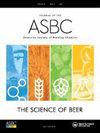Changes in Diacetyl and Amino Acid Concentration during the Fermentation of Dry-Hopped Beer: A Look at Twelve Saccharomyces Species and Strains
IF 1.8
4区 农林科学
Q4 BIOTECHNOLOGY & APPLIED MICROBIOLOGY
Journal of the American Society of Brewing Chemists
Pub Date : 2022-06-20
DOI:10.1080/03610470.2022.2078946
引用次数: 1
Abstract
Abstract Hops were traditionally used in brewing for the addition of isomerized alpha acids that balance the sugary wort with bitterness, though modern breweries are dry-hopping to add complex and unique aromas to their beers. An unintended consequence of high amounts of dry-hopping is the phenomenon known as hop creep, causing an increase in alcohol, carbonation, and diacetyl concentrations. The amount of diacetyl in a beer can be directly correlated to yeast health and vitality, controlled by the amount of free amino nitrogen (FAN) available to the yeast. In this study, both diacetyl and amino acid concentrations were measured prior to and 24 h after dry-hopping, at terminal gravity, and at the start of fermentation. These values were compared across twelve yeasts that are commonly used in dry-hopped beer or offer unique characteristics to fermentation. Experimental yeasts BY881, WLP518, K-97, and CK S102 all exhibited diacetyl concentrations below the aroma threshold for beer. The addition of dry-hops added a significant (p < 0.05) increase in FAN content to the fermenting beers, with most of the increases in serine, arginine, glutamate/glutamine, alanine, and glycine. These increases did not parallel the amino acid content measured in the grist or hops, where asparagine/aspartic acid, proline, and glutamate/glutamine were most prominent. Correlations between total FAN content and diacetyl concentration were calculated, as diacetyl is a precursor in the biosynthesis pathway of the amino acids valine and leucine. However, in this experiment, no correlation of amino acid and diacetyl concentration was observed between dry-hopped and traditional fermentations.啤酒干发酵过程中二乙酰基和氨基酸浓度的变化——以12种酿酒酵母为例
摘要啤酒花传统上用于酿造添加异构化的α酸,以平衡含糖麦芽汁和苦味,尽管现代啤酒厂都在干啤酒花中为啤酒添加复杂而独特的香气。大量干跳的一个意外后果是所谓的跳变现象,导致酒精、碳酸化和二乙酰浓度增加。啤酒中二乙酰的含量可以与酵母的健康和活力直接相关,由酵母可用的游离氨基氮(FAN)的含量控制。在本研究中,二乙酰和氨基酸的浓度均在24 h,在干跳后,在终重力下,以及在发酵开始时。对12种酵母的这些值进行了比较,这些酵母通常用于干啤酒或具有独特的发酵特性。实验酵母BY881、WLP518、K-97和CK S102都表现出低于啤酒香气阈值的二乙酰浓度。干啤酒花的添加显著增加了(p < 0.05)发酵啤酒中FAN含量的增加,其中丝氨酸、精氨酸、谷氨酸/谷氨酰胺、丙氨酸和甘氨酸的增加最多。这些增加与在谷物或啤酒花中测得的氨基酸含量不平行,其中天冬酰胺/天冬氨酸、脯氨酸和谷氨酸/谷氨酰胺最为突出。计算了FAN总含量和二乙酰浓度之间的相关性,因为二乙酰是氨基酸缬氨酸和亮氨酸生物合成途径中的前体。然而,在这个实验中,在干跳和传统发酵之间没有观察到氨基酸和二乙酰浓度的相关性。
本文章由计算机程序翻译,如有差异,请以英文原文为准。
求助全文
约1分钟内获得全文
求助全文
来源期刊

Journal of the American Society of Brewing Chemists
工程技术-生物工程与应用微生物
CiteScore
4.00
自引率
20.00%
发文量
41
审稿时长
3 months
期刊介绍:
The Journal of the American Society of Brewing Chemists publishes scientific papers, review articles, and technical reports pertaining to the chemistry, microbiology, and technology of brewing and distilling, as well as the analytical techniques used in the malting, brewing, and distilling industries.
 求助内容:
求助内容: 应助结果提醒方式:
应助结果提醒方式:


